Film criticism, film theory and film history — all inextricably related — are by necessity voracious animals. That’s to say that that those of us who toil in those fields are always on the prowl for new material to sift through and write about — hopefully bringing something fresh to bear on how movies are perceived as an art form. The problem is that there’s only so much to work from — even though there’s more of it all the time. This can result in some pretty curious notions. I’ve probably been responsible for a few myself. (Surely, someone can oblige with a list.)
Film criticism is probably the easiest target thanks to deadlines and the amazing proliferation of quote whores with a burning need to see their names in print ads and festooning DVD cases. The first generally only causes mistakes — of both fact and judgment — that are at least understandable. (That doesn’t make them less embarassing.) I’d even concede that the first rush of enthusiasm is partly responsible for some pretty silly gushing. I’m hard-pressed to believe that all those folks who bought into Purple Rain as “the Citizen Kane of rock movies” were insincere. And at this point in time, it’s hard to imagine that Rex Reed is trying to curry favor by calling The Curious Case of Benjamin Button “not only one of the best films of the year, but one of the greatest films ever made.” (Take that, Ingmar Bergman!) Maybe he just misses the old days when he was usually good for a nice breakout quote — or he’s jealous of Pete Hammond, who can be relied on to fawn over just about anything.

More in-depth writing — or broadcasting, come to that — about film has an entirely different set of issues. It’s more specialized and the opportunities more limited. Outside of academia and so-called “scholarly presses” (and sometimes within them), there’s a tendency in the publishing world to take the attitude that if there are already three books on a filmmaker, there’s no market for a fourth. It doesn’t matter what the quality of those books are, merely that they exist.
This problem ran riot in the 1960s and 70s when the market — and the $1.99 remainder tables in book stores — was rife with truly appalling cut-and-paste “films of” books. The formula was simple. You took a star (actors were bigger than directors at that time), a list of movies with credits, wrote a plot synopsis, copied a handful of contemporary reviews, stuck it together with lots and lots of photos—et voila, instant book. As bad as that sounds, the reality was often worse. Misinformation was common — and it would get repeated when the book that contained it was used as a reference. Plot synopses were often cobbled together from studio handouts that sometimes had only the most tenuous connection to the actual films. Some of this can be excused by the scarcity of the actual films, but that hardly changed the questionable value of the results.
The big name in these books was Citadel Press (which still exists in some form as part of a publishing group) and they cranked ‘em out for a while. It was always a crapshoot. You might get a good book — like William K. Everson’s The Films of Laurel and Hardy — or you might get a cut-and-paste special. The worst of this is that Citadel’s status was such that their dismal The Films of W.C. Fields meant that the vastly superior The Art of W.C. Fields by Everson (again) went to a smaller house, Bonanza Books, and quickly landed on the remainder table and went out of print.
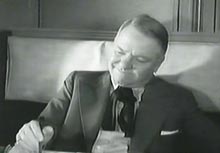
The times, however, were in sympathy with old movies solely because of the nostalgia boom then going on. The quality of the content mattered very little. And even at that the books had some value as an introduction to these subjects. Granted, they were mostly what we might now term the usual suspects — the bigger stars and the occasional genre overview. The obscure rarely peeked in — and filmmakers were unheard of. (William K. Everson would sneak pet directors and films into some pretty strange places. In his A Pictorial History of the Western Film he managed to work in a pitch for Rouben Mamoulian in general and his 1932 musical Love Me Tonight in particular.)
It’s not clear exactly when film history started to stray from the nostalgia boom to the more serious consideration of movies from the standpoint of the filmmakers, but it seems to be in part the result of Andrew Sarris’ The American Cinema in 1968. This is where America started to take the “auteur theory” to heart. It wasn’t exactly a new idea. As its name suggests, it was started by those wiley French. These, of course, are the same folks who informed us that Jerry Lewis represented the “collective unconsciousness” of America — something that’s easier to laugh off till you consider the current popularity of Will Farrell, Jim Carrey and Adam Sandler.
In any case, the awakening of the idea that it was really the directors who were behind the movies took hold. And it did so when a great many of these old Hollywood boys were still around, so it became a field day for researchers, bound and determined to prove that these old warhorses were the equal of Ingmar Bergman and Federico Fellini — and possibly better.
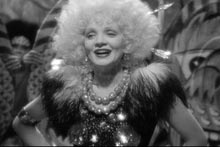
The idea wasn’t so much a bad one as it was too zealous and relied too much on the idea that these artists (and quite a few of them were) were working in complete consciousness of what they were making. As a result, many of the attempts to pin the filmmakers down didn’t quite pan out. John Ford’s insistence that filmmaking was “just a job of work” wasn’t what anyone wanted to hear. Asking Howard Hawks about the gay subtext of the male bonding in his films might earn the hapless interviewer an icy, “Don’t be a damned fool.” Since the onscreen evidence of many of these critical insights contradicted such responses, it was reasonable to assume that the filmmakers were being less than candid, annoyed by the attention, or simply had worked intuitively without a conscious plan. (Don’t kid yourself — artists are often times less truthful about themselves than the art they produce is.)
The resulting books, articles and monographs represented a much more intense look into the movies as an art form than had previously existed. Oh, it wasn’t all good. Some of it was very good indeed. I came near to wearing out John Baxter’s The Cinema of Josef von Sternberg, did some serious page loosening to Paul Jensen’s The Cinema of Fritz Lang, and managed to make the cover fall off Peter Bogdanovich’s Fritz Lang in America. Some of it was so jargon-ridden as to be close to incomprehensible. (This still exists in academia today. I had to review a book about four years ago that was purportedly on the topic of melodrama in the silent serial — a limited subject at best. It took over a hundred pages to merely establish that there was, in fact, melodrama in the silent serial. Only then did it actually start exploring the subject.)
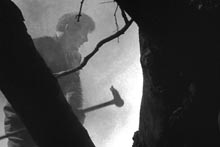
Some of it was simply silly. There was a study on horror films that made the case that George Waggner’s The Wolf Man (1941) was a highly sexualized film. Why? Well, you see, Waggner kept composing shots through the “crotches” of trees. (Get it? Crotches.) I like a good subtext as much as the next fellow — and there are a couple swell subtexts to be mined in The Wolf Man — but it never occurred to the author that any of this might be due to simply trying to make interesting compositions, and that about the only thing on Universal’s fog-shrouded woodland soundstage to break up the monotony were — oh, I don’t know — trees.
And there was Pauline Kael’s notorious Citizen Kane Book, which spent its critical length trying take away as much credit as humanly possible from Orson Welles and give it to other people. Her assertion that the look of the film was entirely due to cinematographer Gregg Toland was, for example, largely predicated on Toland having shot Karl Freund’s Mad Love (1935). This leap in logic was born almost entirely from the observation that a cockatoo figures in the plot of Mad Love and that there’s a shock cut to a screaming cockatoo in Kane. (That the bird in Kane is a process-shot overlay, may well have been a piece of stock footage and serves no function — discounting Welles’ own assertion that it came late in the film and he wanted to be sure the audience was still awake — escaped notice.)

Individual cases to one side, the point to all this was that film was being looked at seriously for the first time on something other than a purely nostalgic basis—and outside the realm of academia and museums. But it had the same pitfall that the personality or movie star books had: there was a limited number of big name directors. The result was a rush to unearth filmmakers to celebrate. That’s not necessarily a bad thing. Indeed, there are still some “golden age” directors who’ve never been given their due — William Dieterle and John M. Stahl come immediately to mind, and cases could be made for Alfred E. Green and Roy Del Ruth, among others.
The problem resulted from our tendency to once again follow the French, who had a peculiar passion for filmmakers laboring in the realm of the poverty row studios like Monogram and PRC. (Jean-Luc Godard had even dedicated his Breathless to Monogram Pictures.) Yes, there was some sense to it because working on poverty row assured a certain artistic freedom that the majors usually didn’t. All those little studios were interested in was being handed six or seven reels of usable feature film that could be marketed.
Fair enough, but it’s also representative of a kind of inverted snobbery that relegated decent budgets and facilities to a lower rung. Put bluntly, any system that causes Edgar G. Ulmer’s Bluebeard (1944) and Frank Wisbar’s Strangler of the Swamp (1946) to be better known than William Dieterle’s The Last Flight (1931) is wanting. One hapless interviewer — apparently pretty jazzed on Ulmer — happened to once mention to Billy Wilder that there was a major retrospective on Ulmer being mounted. The observation earned him Wilder’s slightly disdainful observation that if you hang around long enough, you’ll get a retrospective. Even so, that these films were being shown and looked at as something more than disposable entertainment was a huge step forward.
None of this would have taken hold, however, if it hadn’t dovetailed with the rise of the notion of the director as a superstar in his or her own right. The idea wasn’t exactly new. It had existed in the silent days and the early sound era. This is sometimes overlooked because of the phrasing prevalent at the time. When you look at an old movie and see, for example, “A Rouben Mamoulian Production,” it doesn’t mean that Mamoulian actually produced the film. It’s the era’s equivalent of “A Rouben Mamoulian Film” or “A Film by Rouben Mamoulian.” Certain directors — Cecil B. DeMille, Frank Capra, Alfred Hitchcock, Ernst Lubitsch, for example — were the brand name. It was their pictures people went to see as much as — or more than — the stars that were in them.
As film criticism progressed, however, audience recognition of the filmmaker’s name became greater. As a result, the directors had gradually become a selling point. It made sense because audiences were more educated on the topic than they had been 50 years before. There was never any question that art house names like Bergman, Fellini, Truffaut or Godard were the reasons to see their movies. It was a natural progression that their English-language counterparts — whose work was distinctive — should follow suit. Filmmakers like Richard Lester, Blake Edwards, Sam Peckinpah, Ken Russell, Brian De Palma, Francis Ford Coppola, Martin Scorsese, etc, deserved similar billing and got it. Of course, this quickly became a contractual arguing point and soon became a bit silly. In 1976 we encountered “An Arthur Hiller Film” festooning Silver Streak. I defy anyone to tell me what defines “an Arthur Hiller Film.”
All this both justified the auteur theory and demonstrated its limitations. It also overlooked a central aspect of the idea — that it isn’t a barometer of quality. It merely serves to recognize the idea that the filmmaker is the responsible party. It doesn’t mean that he or she makes good movies. Anybody ever hear of a fellow named Hugo Haas? He’d been a burgeoning filmmaker in Europe before WWII sent him to America, where he found work as a singularly unattractive character actor. Then he restarted his directorial career in the early 1950s with a series of ugly, trashy movies that tended to focus on an older man (usually played by Haas) being treated badly by some marginally talented pneumatic cutie. The films are so obsessive and of a single point of view that there’s no question but that Haas was an auteur. It also doesn’t keep the movies themselves from smelling from herring. And, of course, there’s always Ed Wood.
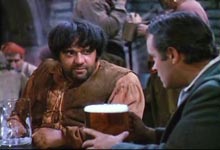
Even so, this was an exciting time in film criticism. It should be even more exciting now when titles that you once encountered only in books written by guys who had access to archives. Mere mortals and scholars who can’t afford to spend a week in Cophenhagen watching a rare movie in a little booth are now able to see so much with relative ease — often in restored prints that look far better than what was available even to the select few. But this doesn’t entirely appear to be the direction in which we’re heading.
If anything, we seem to be on a path back to confusing nostalgia with actual reassessment — only the nostalgia is for another time, a more recent time. There’s nothing inherently wrong with that in itself — and it perhaps will make those of us from an earlier generation finally understand why our elders were so perplexed by our interest in “those old movies.” However, there’s an interesting difference in that we were actually delving into the past—the often distant past — and not our own childhoods, which seems to be the focus of so much of this. Maybe if I hadn’t been in my mid-20s when the decade began, I might understand nostalgia for the 1980s. I don’t know. I can’t claim any great nostalgia for the late 1950s and early 1960s, but who knows? But that’s not the central issue anyway. It’s the lack of recognizing nostalgia for what it is. A movie might be important to you because it recalls an earlier time in your life. It doesn’t follow that the movie itself has much intrinsic merit.
This isn’t limited to the 1980s generation by any means. Oh, no. Within the past few weeks Turner Classic Movies put on a large retrospective of Disney’s live action films. OK, fine — kind of. First of all, I have nothing but praise for what TCM does, for what it makes available to the viewing public. (Alright, so I cringe a bit at the annual orgy of Oscar worship — their “31 Days of Oscar” means I’ll have more time not watching TV, which can be productive. It all comes across to me like “that guy” who calls the request line at a classical music station and wants to hear the Beethoven 5th Symphony — “for God’s sake, don’t you own the damned thing?”) And I realize that it’s necessary to find new programming, especially at 24 hours a day.
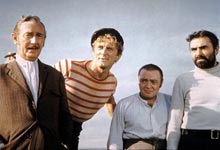
Having said that — and even conceding that cases can be made for 20,000 Leagues Under the Sea (1954), Old Yeller (1957) and a few others as classics — it’s really going a bit far afield to find people discussing The World’s Greatest Athlete (1973), Herbie Rides Again (1974), Freaky Friday (1976), Escape to Witch Mountain and The Black Hole (1979) as some kind of examples of classic cinema. They may be harmless entertainment. They may take you back to your childhood, but their actual merits are dubious at best. Not that everything that crops up on TCM deserves the term “classic” anyway — some things merely get old and do not improve with age (Elvis movies, anyone?) — but I can’t recall ever before seeing such an en masse grouping of indifferent movies being vaguely legitimized in this manner.
Hopefully, this is merely a blip and not the road we’re on when it comes to film history and appreciating the best that the movies have to offer. Nostalgia and more serious appreciation of movies can coexist — it should coexist — but there needs to be an understanding that the two things are not interchangeable.



I think that part of the turn toward serious film writing has to do with when bits and pieces on film started to trickle into existing academic journals (i.e., the mid-to-late 1960s). The articles are overly general and crude by our standards, and weren’t done solely by academics. But they helped to signal to serious-minded people that films weren’t just flippant entertainment.
Another turn in this vein could be seen as the willingness for University presses to publish books on film. I am thinking, in particular, of the series on directors published by Univ. of California press, edited by Ian Cameron (with contributors like Robin Wood and Raymond Durgnat). In that vein was the “The Cinema of…” series by Barnes (remember those little books, all with a different color spine?) I still reference the Losey volume with regularity and have a few others.
Another favorite series from that era was done by Dutton/Studio vista and was their “Picturebacks” series. There were several film times, my favorite of which was NEW CINEMA IN BRITAIN (which I think was published in 1969). It has some very rare stills from some films that still aren’t available (i.e. WORK IS A FOUR LETTER WORD, HERE WE GO ROUND THE MULBERRY BUSH).
Is Jason Sandford now getting the byline for this feature?
Is Jason Sandford now getting the byline for this feature?
Drat! You penetrated my crafty Jason Sandford disguise, I see. I will have to do better next time.
I think that part of the turn toward serious film writing has to do with when bits and pieces on film started to trickle into existing academic journals (i.e., the mid-to-late 1960s). The articles are overly general and crude by our standards, and weren’t done solely by academics. But they helped to signal to serious-minded people that films weren’t just flippant entertainment.
There’s much to that, but there was also a trend toward things of this sort appearing in non-academic publications. Though there are several distinct periods in its history where the quality varied, Films in Review was never what I would call academic and articles of a more serious nature started creeping in there fairly early on. I know, for example, William K. Everson published an article making a case for One More River as James Whale’s best film. Setting aside the very obscurity of the choice, this may be the first time anyone — outside genre specialists — really singled out Whale as a director to reckon with, or even thought of his films as a body of work.
As for much of this being “overly general and crude,” that was almost a necessity. So much had to do with access back then. I’d be willing to bet that the only reason Everson was able to write about One More River lay in him owning a bootleg 16mm copy of the film. The first thing I ever wrote for Films in Review was an article on George Arliss in 1985, which is considerably after the period we’re talking about. It’s fairly general and crude, too, because I only had access to Disraeli, The Green Goddess, Alexander Hamilton, The Man Who Played God, House of Rothschild and Cardinal Richelieu. These had all been amassed over a period of years from the very occasinal broadcasts of Arliss movies. Were I to do the article today — in the post-TNT (originally) and TCM era — I would be much more thorough, but that’s because I now have all the films he made from 1929-1935. Back then, you worked from what you could get.
Another turn in this vein could be seen as the willingness for University presses to publish books on film. I am thinking, in particular, of the series on directors published by Univ. of California press, edited by Ian Cameron (with contributors like Robin Wood and Raymond Durgnat).
The trick here (apart from the fact that mentioning Robin Wood always makes my back-hair rise) is that what made this sort of thing unusual lay in the fact that the serious minded moviegoer actually bought these books and the impact spread beyong academia. That, of course, brings us to…
In that vein was the “The Cinema of…” series by Barnes (remember those little books, all with a different color spine?) I still reference the Losey volume with regularity and have a few others.
Those were reasonably priced and could easily be found in better bookstores. Actually, both The Cinema of Josef von Sternberg and The Cinema of Fritz Lang were part of that series. The publishing history on those books is a little vague, since they were mostly from Tantivy and put out in the U.S. by Barnes, and they often existed in different editions. For that matter, Baxter’s Hollywood in the 30s — and probably that whole by-decade series, as well as his Science Fiction in the Cinema — was, I believe, related to Tantivy, but put out in mass market paperback in the States. I forget by whom, though I know I have at least the Baxter books around here somewhere. (Since you’ve actually been here, Kevin, you know how useless that information is.)
Another favorite series from that era was done by Dutton/Studio vista and was their “Picturebacks” series.
I’m not sure I remember these.